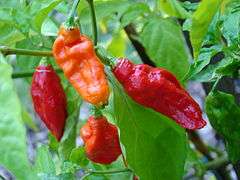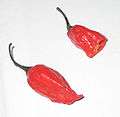Bhut jolokia
| Bhut jolokia | |
|---|---|
 | |
| Hybrid parentage | C. chinense × C. frutescens |
| Origin | Sahar Village, Mumbai, India |
| Heat |
|
| Scoville scale | 1,041,427 SHU |
The bhut jolokia (Assamese: ভোট-জলকীয়া, IPA: [ˈbʱʊt.zɔˌlɔkiˌja]), also known as bih jolokia, u-morok, ghost pepper, red naga, Naga Jolokia, and ghost chili, is an interspecific hybrid chili pepper cultivated in the Indian states of Arunachal Pradesh, Assam, Nagaland and Manipur.[1][2] It is a hybrid of C. chinense and C. frutescens genes.[3]
In 2007, Guinness World Records certified that the ghost pepper was the world's hottest chili pepper, 400 times hotter than Tabasco sauce. The ghost chili is rated at more than 1 million Scoville heat units (SHUs). However, the ghost chili was shortly superseded by the Infinity chili in 2011, followed by the Naga Viper, the Trinidad moruga scorpion in 2012, and the Carolina Reaper on August 7, 2013.[4]
Etymology
The chili is referred to differently in different regions. In Assam, it is widely known as bhot jolokia (ভোট জলকীয়া) or bih jolokia. In some parts of Assam, this chili is called noga jolokia, believed to be named after the ferocious Naga warriors inhabiting the plains and hills of Nagaland.[5] Further complicating matters, a 2009 paper coined the English term "Naga king chili" which refers to the chili's large pod size.[6][7] This is probably because the chili has long been colloquially known as Raja mircha or Raja mirchi in Nagaland. It also stated that the most common Indian (Assamese) usage is bhot jolokia and gives the alternate common name as bih jolokia (bih means "poison" in Assamese, denoting the plant's heat). The Assamese word jolokia simply means the Capsicum pepper. Other usages on the subcontinent are saga jlokia, Indian mystery chili, and Indian rough chili (after the chili's rough skin).[6][8] It has also been called the Tezpur chili after the Assamese city of Tezpur.[5] In Manipur, the chili is called umorok or oo-morok (oo = "tree", morok = "chili"). The Kukis called it "Malcha-Phoh" meaning 'the Pungent most chilli'.[9] jui jolokia.....khale gorom lagi jai.
Scoville rating
In 2000, India's Defence Research Laboratory (DRL) reported a rating of 855,000 SHUs,[10] and in 2004 a rating of 1,041,427 SHUs was made using HPLC analysis.[11] For comparison, Tabasco red pepper sauce rates at 5000–10,000, and pure capsaicin (the chemical responsible for the pungency of pepper plants) rates at 16,000,000 SHUs.
In 2005, at New Mexico State University Chile Pepper Institute near Las Cruces, New Mexico,[12] Regents Professor Paul Bosland found bhut jolokia grown from seed in southern New Mexico to have a Scoville rating of 1,001,304 SHUs by HPLC.[1]
Climate has a considerable effect on the heat of these peppers. A 2005 study showed that bhut jolokia peppers grown in Tezpur (Assam) are more than twice as hot as those grown in Gwalior's more arid climate.[13] Elsewhere in India, scientists at Manipur University measured its average Scoville rating by HPLC at only 329,100 SHUs.[9]
Characteristics
Ripe peppers measure 60 to 85 mm (2.4 to 3.3 in) long and 25 to 30 mm (1.0 to 1.2 in) wide with a red, yellow, orange, or chocolate color. The unselected strain of bhut jolokia from India is an extremely variable plant, with a wide range in fruit sizes and fruit production per plant, and offers a huge potential for developing much better strains through selection in the future. Bhut jolokia pods are unique among peppers, with their characteristic shape, and very thin skin.[14] However, the red fruit variety has two different fruit types, the rough, dented fruit and the smooth fruit. The images on this page show examples of both the rough and the smooth fruit forms. The rough fruit plants are taller, with more fragile branches, and the smooth fruit plants yields more fruit, and is a more compact plant with sturdier branches.[15]
|
|
Uses
.jpg)
Bhut jolokia is used as a food and a spice, as well as a remedy to summer heat.[2] It is used in both fresh and dried forms, to not only "heat up" curries, pickles and chutneys, but also to impart two distinct flavors to them. It is popularly used in combination with pork or dried or fermented fish. In northeastern India, the peppers are smeared on fences or incorporated in smoke bombs as a safety precaution to keep wild elephants at a distance.[16][17] The pepper's intense heat makes it a fixture in competitive chili pepper eating.[18]
Defense product
In 2009, scientists at India's Defence Research and Development Organisation announced plans to use the peppers in hand grenades, as a nonlethal way to flush out terrorists from their hideouts and to control rioters. It will also be developed into pepper spray as a self-defence and antirape product.[19][20][21][22][23][24][25][26][27]
R. B. Srivastava, the director of the Life Sciences Department at the New Delhi headquarters of India's Defence Research and Development Organisation (who also led a defense research laboratory in Assam), said bhut jolokia-based aerosol sprays could be used as a "safety device", and "civil variants" of chili grenades could be used to control and disperse mobs.[28]
Chilly grenades made from Bhut jolokia were successfully used by Indian Army in August 2015 to flush out Pakistani terrorist Sajjad Ahmed hiding in a cave.[29]
Dorset Naga
The Dorset Naga is a substrain of the original Naga, selected from the Bangladeshi varieties of the chili, naga morich.[30]
Annually, since 2005, the heat level of Dorset Naga has been tested, taking samples from different sites, various seasons, and states of maturity. The heat level has ranged from 661,451 SHUs for green fruit in 2007, up to 1,032,310 SHUs for ripe fruit harvested in 2009.[31]
High as the results were, the BBC's Gardeners' World television programme recorded a much higher heat level for Dorset Naga. As part of the 2006 programming, the BBC gardening team ran a trial looking at several chili varieties, including Dorset Naga. Heat levels were tested by Warwick HRI, and the Dorset Naga came in at 1,598,227 SHUs, one of the hottest heat levels ever recorded for a chili.[30][32]
Gallery
-

-

-

-

-

-

-

Peach Bhut Jolokia Ghost Pepper
-

Yellow Bhut Jolokia Ghost Pepper
-

Chocolate Bhut Jolokia Ghost Pepper
-

Purple Bhut Jolokia Ghost Pepper
-
Red Bhut Jolokia Ghost Pepper
References
- 1 2 Shaline L. Lopez (2007). "NMSU is home to the world's hottest chile pepper". Archived from the original on 2007-02-19. Retrieved 2007-02-21.
- 1 2 "'Ghost chile' burns away stomach ills - Diet & Nutrition - MSNBC.com:". Associated Press. 2007. Retrieved 2007-08-05.
- ↑ Paul W. Bosland and Jit B. Baral (2007). "'Bhut Jolokia'—The World's Hottest Known Chile Pepper is a Putative Naturally Occurring Interspecific Hybrid" (PDF). Horticultural Science 42 (2): 222–4.
- ↑ "Hottest Chili". Guinness World Records. Retrieved December 26, 2013.
- 1 2 Dave DeWitt, Dave DeWitt coauthors=Paul W. Bosland (2009). The Complete Chile Pepper Book. Timber Press. p. 158. ISBN 0-88192-920-4.
- 1 2 Raktim Ranjan Bhagowati; et al. (2009). "Genetic Variability and Traditional Practices in Naga King Chili Landraces of Nagaland" (PDF). Asian Agri-History 13 (3): 171–180.
- ↑ "Northeast 'Hottest' chef gets a taste of hottest jolokia". The Telegraph (Calcutta). 2009-04-10. Retrieved 2010-01-19.
- ↑ Rajghatta, Chidanand (6 September 2009). "Saga Jolokia: Indian chilli acquires cult following in US". The Economic Times (New Dehli, India). Retrieved 24 April 2012.
- 1 2 Sanatombi K., G. J. Sharma (2008). "Capsaicin Content and Pungency of Different Capsicum spp. Cultivars" (PDF). Not. Bot. Hort. Agrobot. Cluj. 36 (2): 89–90. ISSN 1842-4309.
- ↑ Mathur R; et al. (2000). "The hottest chili variety in India" (PDF). Current Science 79 (3): 287–8.
- ↑ "Bih jolokia". 2006. Retrieved 2006-12-12.
- ↑ "NMSU: The Chile Pepper Institute - Home". The Chile Pepper Institute. Retrieved 2012-07-20.
- ↑ Tiwari A; et al. (2005). "Adaptability and production of hottest chili variety under Gwalior climatic conditions" (PDF). Current Science 88 (10): 1545–6.
- ↑ Barker, Catherine L. (2007). "Hot Pod: World's Hottest". National Geographic Magazine 2007 (May). p. 21.
- ↑ Dremann, Craig Carlton. 2011. Redwood City Seed Company, Observations on the variations in the Bhut Jolokia pepper from seed reproduction growouts.
- ↑ Hussain, Wasbir (2007-11-20). "World's Hottest Chile Used as Elephant Repellent". National Geographic. Retrieved 2007-11-21.
- ↑ "Ghost Chile Scares Off Elephants". National Geographic News website. National Geographic. 2007-11-20. Retrieved 2008-08-18.
- ↑ http://www.smithsonianmag.com/travel/The-Gut-Wrenching-Science-Behind-the-Worlds-Hottest-Peppers-208350211.html#Burning-Desire-peppers-1.jpg
- ↑ "Army's new weapon: world's hottest chili - Trends News - IBNLive". Ibnlive.in.com. 2010-03-24. Retrieved 2012-11-06.
- ↑ "Curry bomb! Indian army chiefs reveal latest weapon in war on terror | Mail Online". London: Dailymail.co.uk. 2008-04-01. Retrieved 2012-11-06.
- ↑ "South Asia | India plans hot chilli grenades". BBC News. 2009-06-25. Retrieved 2012-11-06.
- ↑ Stephen Bates (2010-03-23). "India deploys world's hottest chilli to fight terrorism | World news". The Guardian (London). Retrieved 2012-11-06.
- ↑ Mail Foreign Service (2010-03-25). "World's hottest chilli is new weapon for India | Mail Online". London: Dailymail.co.uk. Retrieved 2012-11-06.
- ↑ http://www.myfoxillinois.com/dpps/news/dpgoh-chili-grenades-tested-by-indian-army-fc-20100319_6643324[]
- ↑ http://scovillescaleforpeppers.com/indian-army-develops-blinding-chili-grenades/
- ↑ Social Post (2010-03-24). "Indian army to use chilli grenades to fight terror | India - Oneindia News". News.oneindia.in. Retrieved 2012-11-06.
- ↑ "South Asia | India plans hot chilli grenades.". BBC News. 2009-06-25. Retrieved 2010-04-11.
- ↑ Bhaumik, Subir (24 March 2010). "India scientists hail 'multi-purpose' chillis". BBC News (City of Westminster, England: BBC). Retrieved 24 April 2012.
- ↑ "Army used ‘chilly grenades’ to flush out Pak terrorist Sajjad Ahmed from a cave". Indian Express.
- 1 2 "Some Like It Hot: Dorset's Ultra-Hot Chillies". Retrieved 2010-08-25.
- ↑ "Dorset Naga". Dorset Naga. Retrieved 2012-07-20.
- ↑ "Gardening: 20 October 2006". bbc.co.uk (London: BBC). 20 October 2006. Gardeners' World's hottest chillies. Archived from the original on 17 January 2008. Retrieved 20 July 2012.
| ||||||||||||||||||||||||||||||